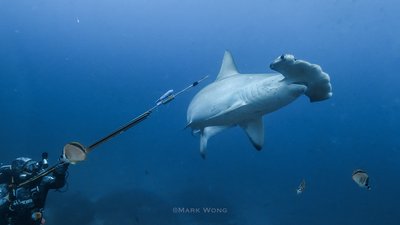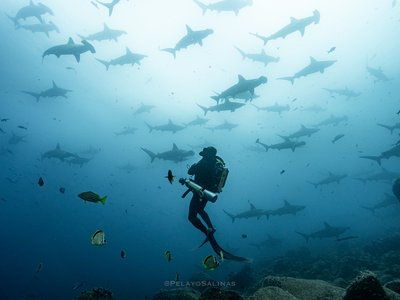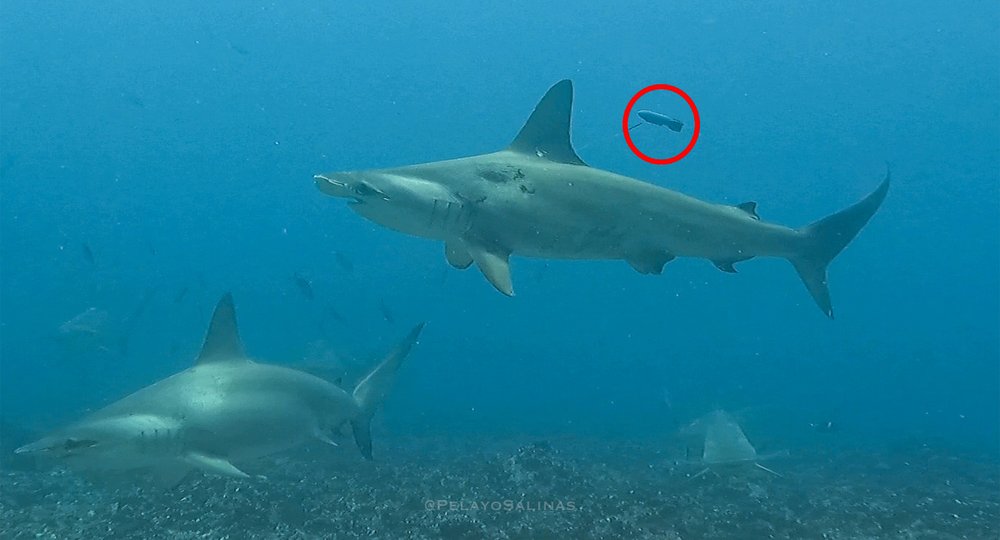Satellite tagging reveals likely first-ever documented birthing migration of the scalloped hammerhead shark
Santa Cruz, Galapagos, Ecuador, 3 July 2025— Scientists from the Charles Darwin Foundation’s shark ecology and conservation program, the Save Our Seas Foundation Shark Research Center and Guy Harvey Research Institute at Nova Southeastern University (USA), and the Galapagos National Park Directorate (GNPD), have published what is likely the first-ever scientifically recorded birthing migration for the critically endangered scalloped hammerhead shark (Sphyrna lewini). The satellite-tagged shark—an adult female displaying a clearly distended abdomen, strongly suggesting pregnancy—traveled between the Galapagos Islands, the coast of Panama and international waters to the west of the Galapagos. During the nearly seven months the shark was tracked, she traveled almost 6,000 km (3728 miles), the longest distance a scalloped hammerhead has been tracked to date. The study was published today in the special issue "Frontiers in Elasmobranch Biology" of the journal Environmental Biology of Fishes.


Researchers used Closed Circuit Rebreathers (CCR) to closely approach this elusive species, when sharks visited the numerous reef fish cleaning stations around Darwin Island, the northernmost island in the Galapagos Marine Reserve, Ecuador. Scalloped hammerhead sharks are known to be very shy to the bubbles and sounds produced by traditional SCUBA diving gear, and also to be extremely sensitive to handling stress produced when captured. Using silent CCR, which produce no bubbles, scientists managed to approach within two meters of the sharks and deploy a minimally invasive, towed satellite transmitter near the base of the dorsal fin with a modified speargun, significantly reducing stress on the animal. Towed satellite transmitters, similar to a GPS device, provide accurate location data in near-real time whenever the shark swims near the ocean’s surface. These tags, designed to resemble a remora fish swimming next to the shark, allowed researchers to follow the movements of the >2.7m, likely pregnant shark for nearly seven months.

The female scalloped hammerhead shark, nicknamed “Alicia,” was tagged on the 11th of February 2023 at Darwin Island and lingered within the vicinity of Darwin for more than two months. In early May, “Alicia”, traveled 1,300 km to the Gulf of Chiriqui on the Pacific coast of Panama, a known nursery area for this species. After just six days in Panama’s coastal waters, where researchers believe ‘Alicia’ gave birth to somewhere between 15 to 30 pups, the shark initiated a 3,000 km westerly migration, settling by late July in an area in international waters more than 1,800 km west of the Galapagos Marine Reserve. She remained there until the tag’s battery exhausted and emitted its final location on September 3rd.

“It is hard to believe how little we still know about the basic life history of most shark species, including this one critically threatened with extinction. Alicia’s clearly distended abdomen at tagging, combined with her brief visit to known birthing grounds in Panama coastal areas during the peak time of newborn sharks occurrence, made us conclude this published satellite track represents the first documented birthing migration recorded for this species. Importantly, it provides critical insights on the complex life cycles and long-range movements scalloped hammerhead sharks undertake to give birth to their young, and underscores the need to further protect endangered sharks beyond already established Marine Protected Areas. Despite their critical conservation status, pregnant hammerheads continue to be fished while migrating, and newborn sharks are fished daily within most coastal nurseries”, said Dr. Pelayo Salinas de León, Senior Marine Scientist at the Charles Darwin Foundation.
The scalloped hammerhead shark was categorized in 2019 as Critically Endangered by the Red List of Threatened Species issued by the International Union for Conservation of Nature (IUCN), based on an estimated global populations decline of >80% over three generation lengths (72.3 years). Despite this critical conservation status, which is at the same threat level as the charismatic Eastern gorilla (Gorilla beringei) or the Galapagos’ Mangrove finch (Camarhynchus heliobates), fins from scalloped hammerhead sharks fished across the Eastern Tropical Pacific continue to flood shark fin markets mainly located in Asia. The long period of time this shark was tracked within international waters to the west of the GMR (~77 days, equivalent to about 40% of total tracked time), also highlights the urgent need for international cooperation to reduce fishing mortality in the high seas in order to revert ongoing population declines for this iconic species.
“Getting this unprecedented view of the long-distance journey by this scalloped hammerhead shark from the Galapagos Islands to the mainland coast to give birth, followed by her return travel westward going well beyond Galapagos, far into the Pacific Ocean, provides new knowledge not only on the reproductive behavior but also extensive migratory capabilities of this species”, says Prof. Mahmood Shivji, Director of the Guy Harvey Research Institute and Save Our Seas Foundation Shark Research Center at NSU Florida. “Such new knowledge should aid the planning of where to focus additional conservation actions in the Eastern Tropical Pacific to preserve this highly endangered shark.”
This research was possible thanks to the generous support of the Rohr Foundation, the Save Our Seas Foundation, the Darwin and Wolf Conservation Fund and the Guy Harvey Ocean Foundation.
For press inquiries, please contact:
Charles Darwin Foundation
Ambre Tanty-Lamothe or Daniela Ibarra | comunicacion@fcdarwin.org.ec
About the Charles Darwin Foundation
The Charles Darwin Foundation for the Galápagos Islands (CDF) is an international non-profit organization that has operated in Galápagos since 1959 under a special agreement with the Government of Ecuador. Its mission, and that of its Research Station, is to address the greatest threats and challenges facing Galápagos through scientific research and conservation actions, to protect one of the world’s most important natural treasures. Today CDF supports more than 25 research, conservation, and education projects across land and sea, and is the custodian of over 137,000 specimens in its Natural History Collections. Its diverse team of more than 140 scientists, educators, and support staff is composed primarily of Ecuadorian citizens, with over 60 % from Galápagos. For more information, please visit: www.darwinfoundation.org





